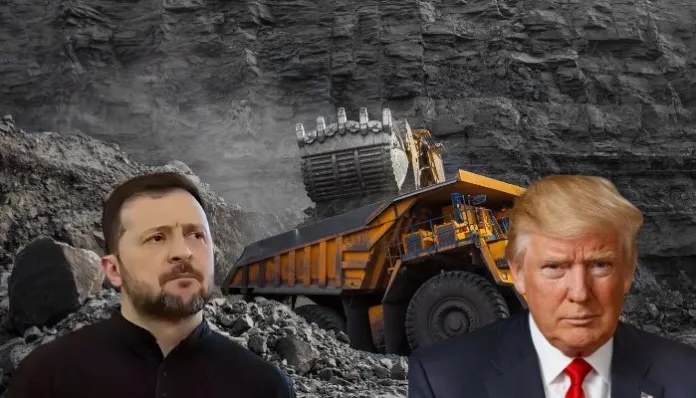The Minerals Deal: A Critical Step in Ukraine’s Path Towards Independence


In his infamous 2021 essay, “On the Historical Unity of Russians and Ukrainians”, published just 7 months before the full-scale invasion, President Putin insisted that the “true sovereignty of Ukraine is possible only in partnership with Russia.” While not only objectively false historically, considering the centuries in which much of modern Ukraine has existed outside Moscow’s orbit, Ukrainians are well aware that “partnership” with Russia is simply a euphemism for subjugation. So when Putin ordered the invasion in February 2022, based on this inaccurate vision, there were no flowers and chocolate for the aggressors as Putin imagined. Instead, Ukrainians fought back. They successfully defended Kyiv and repelled the invaders.
Since then, Ukraine has continued to defy Putin’s imperial ambitions for more than three years, and in doing so has progressed towards the centuries-long Ukrainian dream of independence from Muscovy domination. More recently, Ukraine achieved yet another pivotal milestone in its independent, sovereign path. On April 30th, the US and Ukrainian governments signed the US-Ukraine Reconstruction Investment Fund, marking a day to be remembered in Ukrainian history. The deal not only entails vital short-term benefits for Ukraine, but also may provide long-term economic benefits, all while further removing Kyiv from Moscow’s orbit and entrenching Ukraine firmly in the West. Though far from ideal, the deal is a good one for Ukraine.
To begin with, in terms of what this means for US-Ukrainian relations in the near and medium, the agreement confirms US “strategic alignment” with Ukraine. Or, more pointedly, the US is committed to “Ukraine’s free, sovereign future”, as Treasury Secretary Bessent said. The implications of this alignment have already proven to be significant. After the extreme pressure from the White House on Ukraine since Trump’s inauguration, peaking in the humiliating Oval Office spat in February, we have seen consistent and staunch support for Ukraine from the White House since the signing of this deal, including some $700 bn in weaponry, air defense, and parts and training for F-16s. The rhetoric from Trump and the White House has been similarly supportive of Ukraine and antagonistic towards Russia, with Trump and European allies threatening Russia with extreme sanctions, Bessent calling Putin a war criminal, and JD Vance – who called visiting Bucha and Irpin a “propaganda tour” in the Oval Office – likewise noting US’s support for Ukraine’s sovereignty.
This deal and ensuing support did not come easy. Unwilling to trade one colonial master for another, Zelenskyi and the Ukrainians fought back and resisted earlier US extortionist proposals, dangerously putting US support at risk. Meanwhile, behind the scenes the Ukrainian negotiating team got to work and achieved something remarkable for both sides. Not only did they achieve a political victory for Trump, providing him with a desperately needed foreign policy win, but also gave him the political cover for continued support for Ukraine. Moreover, the primary features of this final agreement reveal a genuine partnership between the US and Ukraine. Among other points, Ukraine retains full ownership and control of all resources, the investment fund is split 50/50 between the two sides, Ukraine will not repay past debts to the US, all profits of the first decade must be reinvested in Ukraine, and the US will assist Kyiv in attracting investment from other allied nations.
Yet criticism of the agreement is not entirely unfounded. Aside from some vague terms in the document, the most concerning element is the clear lack of any security guarantees. Though terribly unfortunate, as of the signing of the deal this promise of long-term US involvement in Ukraine was the best that Kyiv could realistically obtain. Had this deal been signed in late January, we should have rightly lamented its terms; however, as previously unthinkable downside scenarios became increasingly likely over the past few months, we should now warmly welcome this deal. It not only ensures long-term US alignment with Ukraine, but also provides critically needed military and financial aid in the near term.
As for the long-term economic implications for Ukraine, potential benefits exist but are admittedly less clear. Broadly speaking, the deal paves the way for US investment of capital alongside American expertise and business standards. Reorienting Ukraine’s economy towards the West and away from the systemic corruption of the past, amid Ukraine’s simultaneous EU accession path, will undoubtedly improve transparency and drive foreign investment. More specifically, the deal covers the development of natural resources – not simply critical minerals – widening the aperture of investable projects across the nation. However, the full potential remains too undefined. Not only are the resource deposits poorly understood and based upon very old assessments, but the investment timelines are also extremely long, particularly in the minerals sector. Upfront investments in these sectors are immense and unlikely to start until there is peace, and then several years’ lag until production begins, much less the time needed to reach profitability. Moreover, with 40% of Ukraine’s critical minerals in Russian-occupied territory, and another substantial amount relatively near the line of contact, American businesses may be deterred from investing for some time.
In the end, how should we view the deal? With clear enthusiasm. For both Ukraine’s and Trump’s purposes, such unspecified long-term benefits are all entirely acceptable. In the nearer term, Trump gets a desperately needed domestic political win at the outset of his increasingly unpopular presidency, while Ukraine obtains American political, financial, and military support on its path towards escaping the Russian empire. Ultimately, the deal should not be viewed as an economic/financial agreement but rather as a political one – Ukraine offering perceived future investment concessions as political cover for Trump to continue to provide US political and military support to Kyiv.
In case we are unsure of how to interpret the deal and in need of reassurance, look no further than the Kremlin’s disdain for it, calling it a “disguised plan” for the US to continue the war. And Putin should hate this deal. Just weeks ago he believed he was on the cusp of achieving the dream of nearly every Soviet dictator that preceded him – the destruction of transatlantic unity and NATO. Now, however, matched with rising EU support, the Russian dictator is waking up to the Kremlin’s nightmare – a supportive US united with a revitalizing Europe and increasingly robust Ukraine.
And this is why the minerals deal is so vital: Ukraine is placed firmly in the West, long Kyiv’s dream. A country fighting to become free and independent that respects the rights of the individual has earned a partnership – not subjugation – with a Western ally, confirming yet again that Ukraine is indeed part of Western civilization.
And will never be part of Russia.
Mark McNamee is the Co-Owner/Co-Founder of UBN Network, which helps Western companies invest in Ukraine, and also the Host of the podcast “History in the Making: The War in Ukraine”
Dear Readers, Thank you for donating !!!








